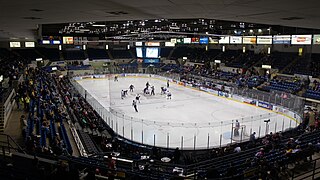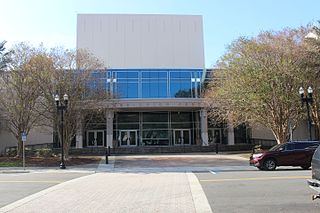
Dow Event Center is an indoor arena located in Saginaw, Michigan. The center consists of several parts: The Atrium, The Garden Room, The Theater, The Red Room, Jolt Event Park, and The Arena. It currently houses the Ontario Hockey League's Saginaw Spirit. The facility has housed a number of hockey teams in the past, such as the Saginaw Lumber Kings and both the IHL and UHL incarnations of the Saginaw Gears.

Bob Carr Theater is an auditorium located in Orlando, Florida. Opening in 1927, the venue is currently owned by the City of Orlando and in 2013, the site was integrated into the Creative Village Development plan.

Mechanics Bank Arena is a multi-purpose arena in Bakersfield, California. Located downtown at the corner of Truxtun Avenue and N Street, it was built in 1998, and was originally known as Centennial Garden, a name submitted by local resident Brian Landis. Bay Area-based Mechanics Bank has held the naming rights since September 2019, following their merger with Rabobank NA, which had held the naming rights since 2005.

The Philadelphia Convention Hall and Civic Center, commonly known simply as the Philadelphia Civic Center, was a convention center complex located in Philadelphia, Pennsylvania. It developed out of a series of buildings dedicated to expanding trade which began with the National Export Exhibition in 1899. The two most significant buildings in the complex were the original main exhibition hall built in 1899, which later housed the Philadelphia Commercial Museum, and the Municipal Auditorium, later called the Convention Hall, which was built in 1931 to the designs of architect Philip H. Johnson. The site was host to national political conventions in 1900, 1936, 1940 and 1948.

The Charleston Coliseum & Convention Center is a municipal complex located in the downtown area of Charleston, West Virginia, United States. Originally completed in 1958, it consists of four main components: the Coliseum, the Theater, the Auditorium, and the Convention Center.

Santa Monica Civic Auditorium is a multi-purpose convention center at 1855 Main Street in Santa Monica, California, owned by the City of Santa Monica. It was built in 1958 and designed by Welton Becket and as a concert venue, it has a seating capacity of 3,000. It is a city-designated landmark, and is listed on the National Register of Historic Places.

Mobile Civic Center is a multi-purpose facility located in Mobile, Alabama. Owned by the City of Mobile and operated by ASM Global, the facility consists of three venues: a theater, an expo hall, and an arena. It is suitable for large indoor events including sporting events and trade shows. The theater seats for 1,938, while the expo hall can seat 3,000. The largest venue of the Mobile Civic Center is the arena, which can seat 10,112.

The Birmingham–Jefferson Convention Complex is an entertainment, sports, and convention complex located in the heart of Birmingham, Alabama's Uptown Entertainment District. The Sheraton Birmingham and Westin Birmingham are located on the campus adjoining the convention center. Alongside over 220,000 square feet of exhibit halls, meeting space, and ballrooms, the complex features four entertainment venues: a stadium, an arena, concert hall, and theatre.
The Ellie Caulkins Opera House is located in Denver, Colorado as part of the large Denver Performing Arts Complex. It seats 2,225. The Caulkins family pledged $7 million towards the enhancement of the lyric opera house and adjacent public spaces which were constructed inside of the Newton Auditorium.
Denver Auditorium Arena was an indoor arena located at the corner of 13th and Champa Streets in Denver, Colorado. It was constructed as the Denver Municipal Auditorium in 1908 during the administration of Mayor Robert W. Speer. The building was opened on July 7, 1908, and was the site of the 1908 Democratic National Convention.

The Bill Graham Civic Auditorium is a multi-purpose arena in San Francisco, California, named after promoter Bill Graham. The arena holds 8,500 people.

The Tulsa Theater is a theater and convention hall located in Tulsa, Oklahoma. It was originally completed in 1914 and remodeled in 1930 and 1952. The building was used as a detention center during the 1921 Tulsa race massacre. It is listed on the National Register of Historic Places and remains in use as a theater today. The theater was previously named after W. Tate Brady but was renamed in 2019 due to Brady's affiliation with the Ku Klux Klan.

The Jacksonville Center for the Performing Arts (JCPA) is a performing arts center located in Jacksonville, Florida. Situated along the Riverbank, the venue is known as the First Coast’s "premiere riverfront entertainment facility". Originally opening in 1962, the facility was renovated beginning in 1995 until 1997; with a grand re-opening on February 8, 1997. The center consists of three venues: a theatre; concert hall and recital hall. It is home to the Jacksonville Symphony, Jacksonville Symphony Youth Orchestra, and the FSCJ Artist Series.

The Olympia Theater is a theater located in Miami, Florida. Designed by John Eberson in his famed atmospheric style, the theater opened in 1926. Throughout its history, the venue has served as a movie theater, concert venue and performing arts center. In 1984, it received historical designation by the NRHP. The Olympia Theatre, the Florida Theatre, and the Tampa Theatre are the only remaining atmospheric theatres in Florida.

Peoria Civic Center is an entertainment complex located in downtown Peoria, Illinois. Designed by Pritzker Prize winning architect Philip Johnson and John Burgee, it has an arena, theater, exhibit hall and meeting rooms. It opened in 1982 and completed an expansion to its lobby and meeting facilities in 2007. On the grounds of the Peoria Civic Center sits the massive "Sonar Tide," the last and largest sculpture of the pioneer of abstract minimalism Ronald Bladen.
The Nederlander Organization, founded in 1912 by David T. Nederlander in Detroit, and currently based in New York City, is one of the largest operators of live theaters and music venues in the United States. Its first acquisition was a lease on the Detroit Opera House in 1912. The building was demolished in 1928. It later operated the Shubert Lafayette Theatre until its demolition in 1964 and the Riviera Theatre, both in Detroit. Since then, the organization has grown to include nine Broadway theaters, making it the second-largest owner of Broadway theaters after the Shubert Organization, and a number of theaters across the United States, including five large theaters in Chicago, plus three West End theatres in London.

The Aztec Theatre is a historic theater in downtown San Antonio, Texas, United States.

The Stifel Theatre is a civic performing arts building located in St. Louis, Missouri.

The Salt Palace was an indoor arena located in downtown Salt Lake City, Utah. Opened in 1969, the building hosted several professional sport teams, concerts, and other special events before it was closed and demolished in the 1990s to make way for the current Salt Palace Convention Center.

The Peacock Theater, formerly Nokia Theatre and Microsoft Theater, is a music and theater venue in downtown Los Angeles, California at L.A. Live. The theater auditorium seats 7,100 and holds one of the largest indoor stages in the United States.




















